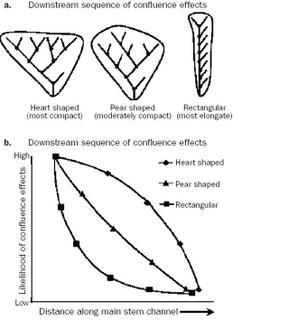Journal Article Review/Opinion
The Network Dynamics Hypothesis: How Channel Networks Structure Riverine Habitats. BioScience: Vol. 54, No. 5, pp. 413–427.
LEE BENDA, N. LEROY POFF, DANIEL MILLER, THOMAS DUNNE, GORDON REEVES, GEORGE PESS, and MICHAEL POLLOCK
 "Figure 4. (a) Network patterns and the associated basin shapes affect the downstream sequence of confluence effects. Common network patterns include dendritic networks, within heart-shaped and pear-shaped basins, and trellis networks, within narrow, rectangular basins. (b) The anticipated downstream sequence of confluence effects (ranging from high to low likelihood) is based on the size of the tributaries relative to the main stems. Dendritic networks in heart-shaped basins promote the greatest likelihood of confluence effects downstream, while trellis networks in rectangular basins promote the fewest effects downstream. Modified from Benda and colleagues (2004)"
"Figure 4. (a) Network patterns and the associated basin shapes affect the downstream sequence of confluence effects. Common network patterns include dendritic networks, within heart-shaped and pear-shaped basins, and trellis networks, within narrow, rectangular basins. (b) The anticipated downstream sequence of confluence effects (ranging from high to low likelihood) is based on the size of the tributaries relative to the main stems. Dendritic networks in heart-shaped basins promote the greatest likelihood of confluence effects downstream, while trellis networks in rectangular basins promote the fewest effects downstream. Modified from Benda and colleagues (2004)"
My rant:
This is a very thought provoking article which links a spatial and temporal context to established ecological principles. In my opinion this information may help explain some conflicting results from seemingly similar studies when placed in the context of where along the stream network these studies were conducted. Many still view natural systems as static. In restoration much of the objective is to resotore a certain site to a previous condition. These natural systems however may be in a constant state of change. This 'change' is sometimes viewed as detrimental but may be a natural progression of the system. Organisms may rely on this change for survival. For example, spawning salmon may rely on disturbances like landslides which provide new gravel for spawning. "anything can be toxic given a high enough dosage". The challenge is determining how much constitutes a 'bad' or detrimental amount. Another consideration is what may be beneficial to one species may not to another. In this way the Endangered Species Act can be detrimental to naturaly ecosystems...But that can be saved for another discussion.
All in all, this article provides a template for which new field studies can be tested, always exciting!
 "Figure 4. (a) Network patterns and the associated basin shapes affect the downstream sequence of confluence effects. Common network patterns include dendritic networks, within heart-shaped and pear-shaped basins, and trellis networks, within narrow, rectangular basins. (b) The anticipated downstream sequence of confluence effects (ranging from high to low likelihood) is based on the size of the tributaries relative to the main stems. Dendritic networks in heart-shaped basins promote the greatest likelihood of confluence effects downstream, while trellis networks in rectangular basins promote the fewest effects downstream. Modified from Benda and colleagues (2004)"
"Figure 4. (a) Network patterns and the associated basin shapes affect the downstream sequence of confluence effects. Common network patterns include dendritic networks, within heart-shaped and pear-shaped basins, and trellis networks, within narrow, rectangular basins. (b) The anticipated downstream sequence of confluence effects (ranging from high to low likelihood) is based on the size of the tributaries relative to the main stems. Dendritic networks in heart-shaped basins promote the greatest likelihood of confluence effects downstream, while trellis networks in rectangular basins promote the fewest effects downstream. Modified from Benda and colleagues (2004)"My rant:
This is a very thought provoking article which links a spatial and temporal context to established ecological principles. In my opinion this information may help explain some conflicting results from seemingly similar studies when placed in the context of where along the stream network these studies were conducted. Many still view natural systems as static. In restoration much of the objective is to resotore a certain site to a previous condition. These natural systems however may be in a constant state of change. This 'change' is sometimes viewed as detrimental but may be a natural progression of the system. Organisms may rely on this change for survival. For example, spawning salmon may rely on disturbances like landslides which provide new gravel for spawning. "anything can be toxic given a high enough dosage". The challenge is determining how much constitutes a 'bad' or detrimental amount. Another consideration is what may be beneficial to one species may not to another. In this way the Endangered Species Act can be detrimental to naturaly ecosystems...But that can be saved for another discussion.
All in all, this article provides a template for which new field studies can be tested, always exciting!

0 Comments:
Post a Comment
<< Home